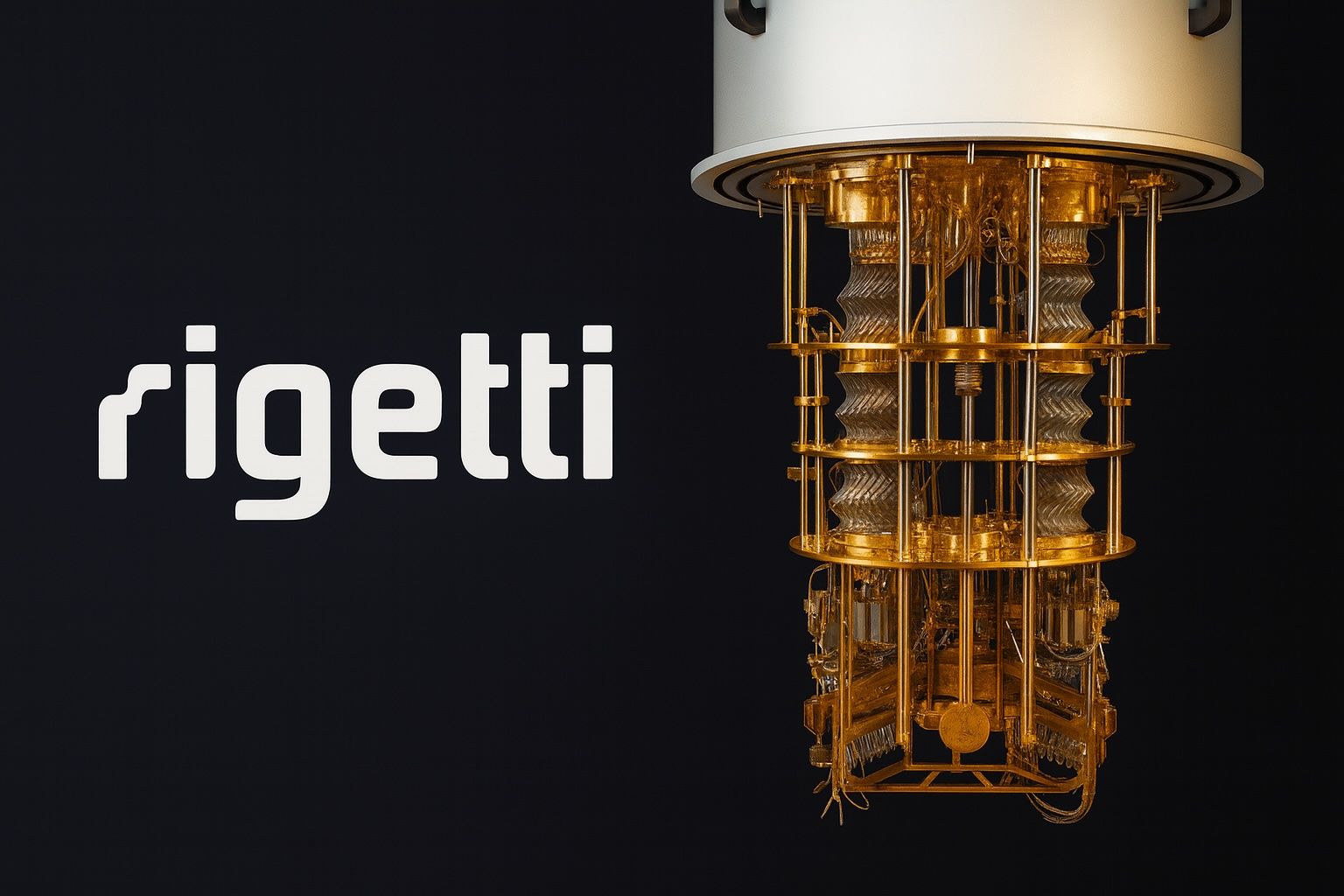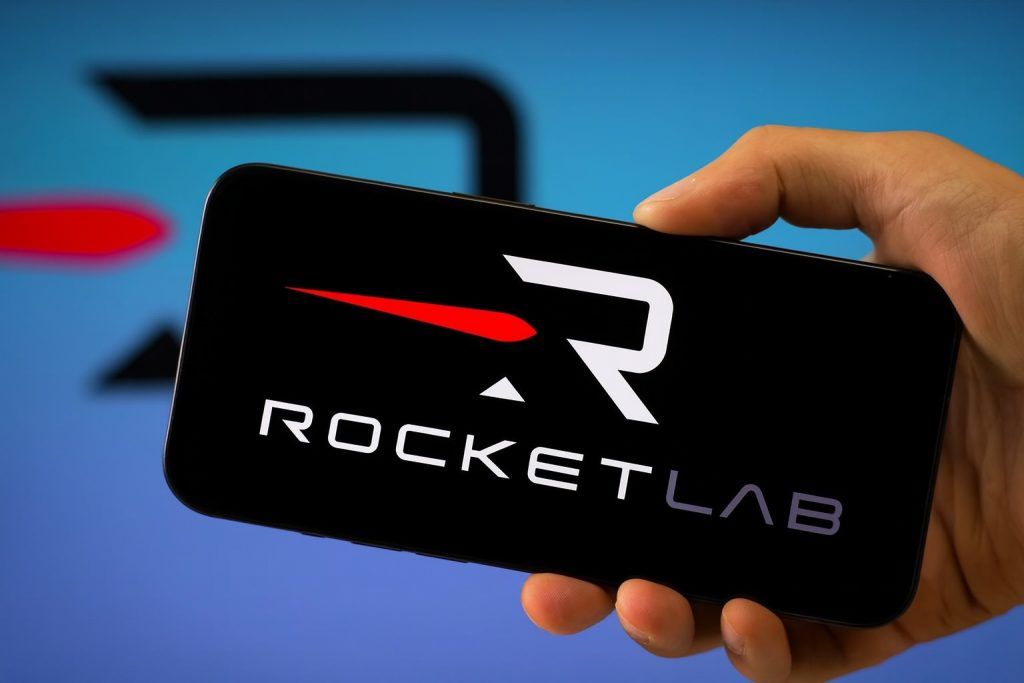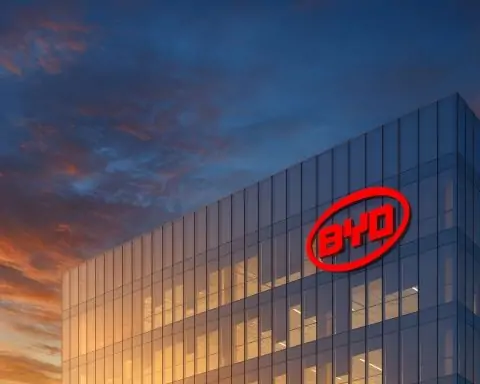- Quantum Stock Rocket: Rigetti Computing’s share price is near record highs (around $40 as of Oct 7, 2025), up roughly 84% in September alone and an astounding ~2,500% year-on-year from penny-stock levels [1]. At this price, Rigetti’s market capitalization is about $11–13 billion [2], reflecting huge investor optimism in the promise of quantum computing.
- Small Deals, Big Impact: Recent catalysts include ~$5.7 million in new orders for Rigetti’s 9-qubit Noveraquantum computers and a $5.8 million U.S. Air Force contract [3]. These relatively small contracts sparked outsized stock gains – Rigetti jumped ~16–19% on the Novera news alone [4] – reinforcing investor confidence that the company is progressing toward commercial viability.
- Tech Milestones & Partnerships: In 2025 Rigetti achieved key technical milestones and alliances. It launched a 36-qubit “Cepheus-1” processor (a modular 4-chip system with 99.5% two-qubit fidelity, doubling performance from six months prior) [5]. It also formed strategic partnerships: a $100M+ collaboration with Quanta Computer (Taiwan) to scale its hardware, an MOU with India’s C-DAC to develop hybrid quantum-classical systems, and deployment of its first on-premises quantum computer at Montana State University – extending Rigetti’s global footprint and credibility [6] [7].
- Bullish Analysts, Tame Targets: Wall Street is optimistic long-term but cautious on valuation. Six of seven analysts rate RGTI a Buy [8], yet their 12-month price targets (averaging ~$20–24) are roughly half the current share price [9]. Notably, Benchmark just raised its target to $50 (Buy) on Oct 7 [10], while others like Needham stay around $18–20 [11] [12]. This gap suggests the stock may be overextended relative to near-term expectations.
- High Hopes vs. Hard Numbers: Rigetti’s valuation has far outpaced its financials. Trailing 12-month revenue is under $8 million and Q2 2025 revenue was just $1.8 million (with a net loss of $39.7 million) [13]. However, the company raised ~$385 million in Q2 (via an ATM equity offering) and ended the quarter with $571.6 million cash and no debt [14] – giving it a sizable R&D war chest. Like peers IonQ and D-Wave, Rigetti is trading on future potential, not current earnings: e.g. IonQ’s market cap hit ~$20 billion on $20.7 M in Q2 revenue, and D-Wave’s ~$10 billion cap rests on ~$3 M in quarterly sales [15] [16]. The entire quantum computing sector is booming in 2025 despite minimal revenues, driven by breakthroughs and investor speculation.
Recent Stock Performance: A Quantum Surge
Rigetti’s stock (NASDAQ: RGTI) has been on a tear in late 2025, skyrocketing to all-time highs heading into October. On October 6, shares topped out around $40.63 (the 52-week high) [17] – astounding considering RGTI traded under $1 one year ago. The rally really accelerated in September: the stock jumped ~83–84% during September alone [18], far outpacing the flat broader market. After hovering around $15 mid-year, RGTI began climbing in early September; between Sept 12 and 19 it spiked from roughly $16 to $28 (+70% in one week) [19]. By Oct 2, Rigetti surged 18.6% in a single day to close at $35.40 (intraday high $35.81) amid trading volume nearly 3× the norm [20] [21]. The very next day (Oct 3), it hit an intraday peak of $40.63 before closing at $40.06, up 13% on the day [22]. Year-to-date, the stock was up roughly 127% by early October [23], and an almost unbelievable ~4,000% higher than a year prior (thanks in part to bouncing off post-SPAC lows) [24].
Such explosive gains reflect intense speculative enthusiasm. Each positive headline has sent the stock higher, amplified by social media buzz and FOMO (fear of missing out) among retail traders [25]. On Oct 2, over 144 million RGTI shares traded – about triple the average volume [26] – as buyers rushed to “get in” on the next big thing in tech. Notably, Rigetti’s spikes often lifted other quantum stocks in sympathy: when Rigetti announced major news, peers D-Wave jumped ~14% and IonQ ~10% alongside it [27]. By early October, Rigetti’s ~+127% YTD performance actually outpaced IonQ (+48% YTD) and was on par with D-Wave (+165% YTD) [28]. In short, RGTI has become one of 2025’s hottest tech stocks, vastly outperforming the S&P 500 and even many AI-related stocks.
However, this parabolic rise comes with volatility and warnings. The stock’s momentum is driven more by sentiment and future hopes than fundamentals – a hallmark of a speculative rally. Minor pullbacks have occurred whenever shares notch new highs, as some investors take profits. Technically, Rigetti is trading well above trend indicators: in early October it was far above its moving averages (the 50-day around $20 and 200-day near $14) [29], a sign of strong upward momentum but also a potentially overbought condition. Many observers caution that Rigetti’s valuation is sprinting ahead of its current reality, making the ride unstable. In the near term, expect continued price swings driven by news flow and trader sentiment. The key question is whether the company’s actual progress can ultimately justify this lofty valuation – or if the stock is leaping too far, too fast.
Major News & Developments (Late 2025)
Rigetti’s recent stock surge has coincided with a flurry of company news signaling progress in turning quantum computing from experiment to enterprise. In the weeks leading up to October 7, 2025, Rigetti announced several key developments that fed the bullish narrative:
- New Customer Orders – Novera Systems ($5.7 M): On Sept 30, Rigetti revealed it secured purchase orders totaling ~$5.7 million for two of its Novera on-premises quantum computers [30]. These are 9-qubit quantum processing units (upgradeable in qubit count) designed for hands-on R&D. Notably, the buyers were commercial/academic clients, not just government labs: one system is going to a large tech manufacturer in Asia, and the other to a California-based AI/physics startup [31]. Delivery is expected in the first half of 2026 [32]. While $5.7 M is a modest amount, it’s significant given Rigetti’s tiny revenue base – roughly 72% of the company’s total revenue over the prior 12 months [33]. Analysts said this sale “reinforced investor confidence in Rigetti’s transition toward commercialization” [34]. Indeed, the stock jumped ~16–19% on the announcement [35]. Rigetti’s CEO, Dr. Subodh Kulkarni, hailed the orders as evidence of “increased demand for on-premises quantum computing systems as the industry matures” [36]. In short, these are the first tangible hardware sales to industry customers, offering real proof that Rigetti’s technology has paying users beyond research consortiums.
- U.S. Air Force Contract – Quantum Networking ($5.8 M): Two weeks earlier, Rigetti announced a 3-year, $5.8 million contract with the U.S. Air Force Research Lab (AFRL) on Sept 18 [37]. Under this award, Rigetti (in partnership with Dutch startup QphoX) will develop superconducting quantum networking technology for the Air Force – essentially working to link Rigetti’s quantum processors with optical photon-based networks for long-distance quantum communication [38]. Kulkarni called it “an exciting opportunity to advance superconducting quantum networking” by combining Rigetti’s qubit expertise with QphoX’s photonic transduction tech [39]. Though $5.8 M is also relatively small, such government R&D contracts validate Rigetti’s tech credibility and provide non-dilutive funding. Investors took notice: Rigetti’s stock popped about 11–12% on the day this AFRL deal was announced [40]. This win shows Rigetti can compete for prestigious federal projects, adding to its stature in the field. (Notably, competitor IonQ has also landed significant U.S. government contracts, underscoring the strategic interest in quantum computing.)
- Technology Milestone – 36-Qubit Cepheus-1 System: In August 2025, Rigetti reached a major technical benchmark by launching “Cepheus-1,” a new 36-qubit quantum processor comprised of 4 linked chiplets [41]. This multi-chip architecture quadrupled Rigetti’s qubit count (up from its prior 8- and 9-qubit generations) while halving two-qubit error rates – achieving 99.5% median two-qubit fidelity versus ~98% previously [42]. Rigetti touts Cepheus-1 as “the industry’s largest multi-chip quantum computer” currently available [43]. It has been deployed on Rigetti’s Quantum Cloud Services and will also be offered via Microsoft’s Azure Quantum cloud [44]. Kulkarni emphasized that scaling qubit count and improving fidelity is “the clear path towards quantum advantage” – the point where quantum machines outperform classical ones [45]. This milestone demonstrates Rigetti’s engineering prowess in integrating multiple superconducting chips, a different scaling strategy than IonQ’s trapped-ion approach. It’s also a stepping stone toward the company’s goal of a 100+ qubit system by end of 2025 [46]. Analysts have cited these R&D advances as justification for optimism on Rigetti’s prospects [47]. While not immediately revenue-generating, the 36-qubit launch signals that Rigetti is pushing the bleeding edge of quantum hardware – progress that underpins the long-term investment thesis.
- Strategic Partnerships & Market Expansion: Rigetti has been actively forging partnerships to bolster its ecosystem and global reach:
• Quanta Collaboration: In Feb 2025, Rigetti entered a $100+ million strategic partnership with Quanta Computer, a major Taiwanese electronics manufacturer [48]. Quanta invested $35 million in Rigetti and the two agreed to co-develop Rigetti’s next-gen quantum hardware. This alliance not only provided capital but also gives Rigetti access to Quanta’s high-volume manufacturing expertise – valuable as Rigetti eventually aims to produce larger quantum systems at scale. Management said Quanta’s backing “will strengthen our leadership… and put us at the forefront of the industry” [49].
• India (C-DAC) Partnership: In Sept 2025, Rigetti signed a memorandum of understanding with India’s premier computing R&D lab, C-DAC (Centre for Development of Advanced Computing) [50]. The collaboration aims to integrate Rigetti’s superconducting quantum processors with India’s high-performance supercomputers to create powerful hybrid quantum-classical systems for applications like optimization and simulation [51]. This aligns Rigetti with India’s national quantum initiative and could open an important new market. It signals that major governments see promise in Rigetti’s technology.
• Academic Deployment: In Aug 2025, Rigetti deployed a Novera 9-qubit system at Montana State University(MSU), marking the company’s first on-premises quantum computer at an academic institution [52]. MSU’s new Quantum Research Center (QCORE) now houses the Rigetti system, giving students and researchers hands-on access to real quantum hardware for research on algorithms and error correction [53]. This is an important proof-of-concept for Rigetti’s “quantum-computer-in-a-box” product for universities and labs, potentially seeding future commercial adoption (and training a pipeline of quantum-savvy talent on Rigetti’s platform).
Together, this flurry of contracts, product launches, and alliances in late 2025 has kept Rigetti in the spotlight. Each development — be it a new sale, a tech breakthrough, or a partnership — has reinforced the narrative that Rigetti is rapidly moving toward commercializing quantum computing. Financial media from Yahoo Finance to Nasdaq.com highlighted how the ~$5.7 M Novera orders and Air Force deal “fueled” Rigetti’s rally by signaling tangible progress [54]. To be sure, these deals are still modest in scale (a couple hardware sales and a grant won’t flip Rigetti’s financial picture overnight). But they demonstrate real demand and interest in Rigetti’s tech, which, if continually built upon, could lead to meaningful revenue in the future. Maintaining this momentum of “good news” is crucial for sustaining investor enthusiasm in a pre-profit company like Rigetti.
Analyst Forecasts and Technical Outlook
Wall Street Coverage: Despite the speculative frenzy, equity analysts covering Rigetti generally remain bullish long term– albeit with much lower price expectations than the market’s current pricing. As of early October, 6 out of 7 analyststracked by MarketBeat rate RGTI a Buy (or Strong Buy), versus 1 Sell [55] [56]. The consensus 12-month price target is around $24 per share [57], which is roughly 50% below the ~$40 level where the stock has been trading. In other words, even bullish analysts believe the stock’s recent surge may have outrun near-term fundamentals. For example, prior to Benchmark’s new upside call, the highest target on the Street was B. Riley’s $35(raised from $19 in late September) [58]. Many others were in the high-teens to low-$20s (Needham reiterated a Buy with an $18 target, for instance) [59].
New $50 Call: On October 7, Benchmark broke from the pack by raising its RGTI target from $20 to $50 and maintaining a Buy rating [60]. This aggressive call – implying ~20% upside from recent prices – indicates some analysts see even more room for the rally to run. Benchmark’s upgrade came on the heels of Rigetti’s contract wins and tech milestones, suggesting they believe these moves significantly enhance the company’s outlook. Still, it’s an outlier stance; most analysts are counseling caution about the stock’s valuation. Notably, one firm (Weiss Ratings) has kept a Sellrating on RGTI as of late September [61], reflecting skepticism. The overall rating lands as a “Moderate Buy”in aggregate, but with a wide divergence in price targets – underscoring the uncertain trajectory and risk level. As one commentator bluntly noted, a ~$10–13 billion market cap against ~$8 million in annual revenue is extreme [62] [63], so any missteps or delays could lead to sharp corrections.
Technical Analysis: From a technical market perspective, Rigetti’s chart has been extremely strong but may be due for a reality check. The stock has been trading well above key moving averages – by Oct 7, the share price (~$40) was doubleits 50-day average (~$20) and nearly 3× its 200-day average (~$14) [64]. Such a steep divergence points to strong upside momentum, but also to overbought conditions that often precede pullbacks. Indeed, momentum indicators like RSI have likely been flashing overbought in recent weeks as the stock went parabolic. Traders have noted that RGTI’s swift run has formed a near-vertical trend – which can invite bouts of profit-taking or volatility if sentiment shifts. Support levels may be far below (previous resistance in the mid-$20s could now act as support, for example). On the upside, if bullishness continues unabated, there isn’t much historical resistance above the recent highs; some optimistic traders are watching the $50 level (Benchmark’s target) as a potential next psychological milestone. The beta of the stock is around 1.6 [65], indicating higher volatility than the market – not surprising given its recent swings. In short, technicals show a strong uptrend and a high-risk profile. Investors should brace for continued large moves in both directions.
Valuation Metrics: By any traditional metric, Rigetti’s stock is extraordinarily valued. At ~$40/share, the company’s price-to-sales ratio is on the order of 900–1000×. (For context, the tech sector average P/S is maybe ~3–10×.) As one analysis noted, investors are “pricing in a quantum revolution” that hasn’t arrived yet [66] [67]. Rigetti’s trailing P/S exceeded 980× and P/B ~18× as of Q3 2025, vastly higher than peers or any normal benchmark [68]. Such multiples imply investors expect exponential growth – essentially, they are valuing Rigetti on what it might earn years from now if quantum computing becomes mainstream. This leaves no margin for error. Any hint of delays in commercialization or failure to meet technical roadmaps could trigger a sharp de-rating. Conversely, continued “dream” news could keep the hype going. It’s a classic high-risk, high-reward scenario: the stock could swing wildly on sentiment long before fundamentals catch up. Even analysts supportive of Rigetti emphasize that the company trades on future potential rather than current fundamentals, making it more akin to a venture capital bet than a value investment [69] [70]. As TipRanks analyst Casey Dylan put it, “the stock [is] less as a stable investment and more as a lottery ticket on the commercial breakthrough of quantum computing” [71]. In other words, RGTI is a speculative play that could pay off big if quantum tech advances rapidly – but it could also disappoint if that timeline slips.
Insider & Sentiment Signals: It’s also telling that some insiders have been cashing out during the run-up. According to filings, Rigetti executives and directors sold more than $3 million worth of shares since July 2025 (much of it through automatic sales/programs) [72]. While insiders may sell for many reasons, unloading stock into a massive rally suggests at least some insiders are happy to lock in gains at these levels. Meanwhile, short interest in RGTI sits around ~14% of float [73], indicating a minority of investors are betting on a pullback (or hedging). Major institutions have also taken positions – for instance, Vanguard increased its stake by 60% in Q2 [74] – showing that some long-term investors want exposure, perhaps balancing out the shorts. The overall market sentiment on Rigetti borders on frenzy: message boards and Reddit forums have lit up with “quantum fever” and meme-stock style buzz [75]. This retail enthusiasm can be a double-edged sword: it propels stock spikes, but can reverse quickly on bad news. Going forward, watch for analyst revisions (up or down), insider transaction trends, and news flow as key drivers of RGTI’s volatile mix of fundamentals and sentiment.
Expert Commentary & Rigetti’s Position in Quantum Computing
Rigetti’s remarkable rise has invited a range of expert opinions – from exuberant to cautionary – about the company’s positioning in the nascent quantum computing industry. As one of the few pure-play publicly traded quantum companies, Rigetti is often seen as a bellwether for investor appetite in this frontier tech space. Here’s what experts and industry observers are saying:
“High-Risk Lottery Ticket”: Many analysts emphasize that Rigetti offers huge potential and huge risk. The Motley Fool flatly described Rigetti as “lottery-ticket exposure to a potentially transformative technology” – suitable only for risk-tolerant investors [76]. The disconnect between Rigetti’s tiny revenues and its $10B+ valuation means investors are effectively betting on future breakthroughs. “At 990 times sales, you’re paying today for a tomorrow that might not arrive on schedule,” the Motley Fool piece warned [77]. Similarly, TipRanks’ Casey Dylan, while optimistic about quantum computing’s future, views RGTI as a speculative bet: “defined by high risk, but potentially yielding enormous rewards” if the technology pays off [78]. The consensus is that Rigetti’s stock is not grounded in present performance, but in the hope that it will eventually monetize quantum advantage in a big way. That could take years, and there’s no guarantee of success – hence the repeated “lottery ticket” analogies.
Cramer’s Take – Speculation with Upside: CNBC’s Jim Cramer – known for his blunt assessments – has offered mixed commentary on Rigetti. Earlier in the year, amid skepticism about quantum timelines, Cramer allegedly called RGTI “the worst [quantum stock]” to own. But as the stock surged, Cramer acknowledged the improving story. “Okay, here’s my view on quantum computing: it is for real. Is Rigetti my favorite? No… but Rigetti’s one that could have a headline tomorrow – I don’t want to keep you out of it,” Cramer said recently [79]. He still cautioned that “it is a speculation, please remember that”, yet conceded “Rigetti could have something that could be a home run” if a breakthrough comes [80]. In essence, even skeptics like Cramer now see enough progress that they wouldn’t categorically tell investors to avoid RGTI – as long as they size it as a speculative position. This shift from “stay away” to “could be worth a look (with caution)” highlights how Rigetti’s advancements (like the 36-qubit chip and government deals) have lent the company a bit more credibility. Still, Cramer’s bottom line is that Rigetti is far from a sure thing, and only suitable for those willing to speculate.
Positioning vs. Competitors: In the race to build viable quantum computers, Rigetti faces formidable competition – but also a massive opportunity. Its main public-market peers are IonQ (IONQ) and D-Wave Quantum (QBTS). All three have seen spectacular stock surges in 2025 amid renewed quantum optimism [81]. IonQ, which focuses on trapped-ion quantum tech, is arguably ahead in terms of revenue (it reported $20.5 M revenue in 2022 and ~$4.3 M in Q2 2025) and has landed larger contracts (over $50 M in U.S. government deals) [82]. IonQ’s market cap soared above $20 billion at one point [83], even higher than Rigetti’s, illustrating that investors are excited about multiple players in this field. D-Wave, which uses quantum annealing technology, has lower revenue (~$7 M in 2022, ~$1 M quarterly) and an even more extreme valuation multiple. All these companies are pre-commercial in terms of profits, so the market is valuing them on technological milestones and strategic wins. Rigetti’s edge, relative to IonQ and D-Wave, is its “full-stack” approach (developing both superconducting quantum hardware and the software/services around it) [84]. It was a pioneer in offering cloud-based quantum access (since 2017) and now is selling turnkey on-premises systems, which peers haven’t done yet [85]. Rigetti’s use of a superconducting qubit platform puts it in the same fundamental tech camp as Google, IBM, and other U.S. labs – which could make its know-how attractive if big tech or governments seek partners or acquisitions.
Industry Endorsements: The broader quantum computing field remains extremely nascent, but it’s receiving validation from both industry leaders and national governments. A Bank of America strategist recently called quantum computing “the most important technological race of our generation” [86], underscoring why so much capital (and hype) is flowing into names like Rigetti. Tech giants such as IBM, Google, and Microsoft are pouring billions into quantum R&D (though those conglomerates aren’t pure plays like RGTI) [87]. Their progress lends credibility that quantum breakthroughs will happen – it’s no longer an “if,” but a “when.” This rising tide lifts companies like Rigetti, which can position themselves as leaders in a future multi-billion dollar industry. Experts note that Rigetti, IonQ, and others are essentially in a race for technical supremacy and customer adoption; the winners could see enormous rewards, while laggards may struggle. At this stage, no company has demonstrated true “quantum advantage” in a commercial setting – but Rigetti’s recent 36-qubit high-fidelity achievement is seen as one step on that path [88]. And the fact that Rigetti’s systems are being used by national labs and universities across the world suggests it is among the forefront of this revolution.
Skepticism and Timing: Despite excitement, seasoned observers urge caution on the timeline. Some industry experts suggest that meaningful commercial quantum applications won’t emerge until ~2030 or later [89]. That means Rigetti (and its investors) may need patience through years of continued development, with the risk of hype cycles rising and fading. The current frenzy in quantum stocks has drawn parallels to past tech bubbles – investors might be “pricing in” success a bit too early. The Wall Street Journal, for instance, recently highlighted the “hidden cost” of speculating on emerging tech stocks, noting sharp swings in names like Rigetti [90]. In practical terms, Rigetti will have to execute flawlessly to grow into its valuation: it must scale from ~$2M quarterly revenue to hundreds of millions (or more) over coming years, which will require selling larger systems, cloud services, or other offerings at a much greater clip. The company’s hefty cash reserve ($571 M) gives it a runway of several years to pursue that growth [91] [92]. But it will burn through that war chest if it can’t start generating bigger revenues before the decade’s end. This dynamic – big cash buffer vs. high burn rate – is something experts keep a close eye on.
In summary, Rigetti’s strategic position in the quantum space is that of a well-funded, technically adept contender in a field that promises to reshape computing. It has proven its ability to build working quantum processors and attract interest from governments, academia, and industry partners. Those are encouraging signs. However, the road to commercialization is still long and uncertain. As expert commentators note, owning RGTI stock today is effectively a bet that Rigetti will be among the winners of the quantum revolution – a race that is just beginning. It’s a thrilling narrative, but one not without significant risk. As one analyst quipped, investing in Rigetti is like buying a ticket for a rocket launch whose destination (and landing) is still unknown.
Quantum Computing Sector Context and Competitor Comparison
Rigetti’s story can’t be viewed in isolation – it’s part of a broader quantum computing boom in 2025 that has lifted multiple stocks and stoked both excitement and bubble concerns. A quick look at Rigetti’s peers and the overall sector trends:
Peers Soaring on Potential: Aside from Rigetti, the two other publicly traded pure-plays are IonQ (IONQ) and D-Wave Quantum (QBTS). All three have delivered eye-popping returns over the last year: Rigetti up ~2500% YoY [93], IonQ up ~700% YoY (and ~75% year-to-date) [94], and D-Wave up ~165% YTD [95]. This quantum mini-sector has vastly outperformed the broader market in 2025. Investors are essentially valuing these companies on technological milestones and future market potential, rather than current financials. For instance, IonQ – often cited as an industry leader – now sports a ~$15–20 billion market cap, yet its full-year 2023 revenue was only $11 million and guidance for 2025 is modest (IonQ recorded $4.3 M revenue in Q2 2025) [96]. Its P/S ratio is in the high hundreds (recently ~327× sales) [97]. D-Wave, with just a few million in yearly sales, similarly reached around a $10 billion valuation. Rigetti’s ~$13B value vs. <$8M trailing revenue fits this pattern [98]. Put simply, the market is pricing all these quantum firms not on what they are today, but on what they could become if quantum computing revolutionizes entire industries. This speculative pricing can be volatile – fortunes could be made if even one of these companies achieves a breakthrough, but any stumble could trigger steep declines.
Sympathy and Divergence: Interestingly, quantum stocks have often moved in tandem (a big announcement for one tends to lift others), indicating investors see the sector rising together. For example, when Rigetti’s stock spiked on its news, IonQ and D-Wave also jumped in “sympathy” [99]. All three benefit from general headlines about “quantum supremacy,” government funding for quantum research, or bullish analyst reports on the industry. However, their strategies differ. Rigetti and IBM use superconducting qubits; IonQ uses trapped ions; D-Wave pursues quantum annealing (a different approach aimed at certain optimization problems). Each technology has pros and cons, and it’s too early to declare a winner. It’s possible they will carve out different niches. For now, investors are hedging bets by giving all players a strong valuation uplift.
Broader Tech Giants and Investments: The quantum sector’s momentum is also supported by moves from big tech and governments. In addition to Rigetti’s Quanta and C-DAC partnerships, tech giants like Google, IBM, Microsoft, Amazon are heavily invested in quantum R&D (though none of those efforts are separately traded stocks). IBM has a 127-qubit processor and offers quantum cloud services; Google famously demonstrated a “quantum supremacy” experiment in 2019. These companies validate that quantum computing is real and important, even if profits are years away. Governments, too, are pouring money into quantum. The U.S., EU, and China each have national quantum initiatives budgeting billions for research – a recognition that leadership in this field is strategically vital (for cybersecurity, military, economic reasons). A recent example: the U.S. Department of Energy and military agencies (like the AFRL contract Rigetti won) are funding quantum projects to ensure America isn’t left behind. As mentioned, a Bank of America strategist went so far as to call quantum computing “the most important technological race of our generation” [100]. This kind of rhetoric fuels investor perception that companies like Rigetti sit at the cusp of something transformative (and potentially lucrative on a historic scale).
Market Trends & Hype Cycles: 2025’s surge in quantum stocks has drawn comparisons to other tech trend frenzies. Some see parallels to the early stages of the AI boom or even 1990s dot-coms – a mix of genuine innovation and speculative excess. In fact, the quantum rally has dovetailed with the broader AI rally of 2023–2024 (which saw semiconductor and software stocks soar). Quantum computing is often mentioned as a complement to AI (solving complex problems AI can’t), so it has caught some of the “next big thing” halo effect. There’s also a meme-stock element: retail investors on platforms like Reddit have latched onto quantum as a new theme, sharing quantum memes and YOLO bets on RGTI, IONQ, etc. [101]. Short-term trading dynamics – like momentum funds and option traders piling in – have further exaggerated moves. At the same time, institutional interest is growing: notable hedge funds and ARK Invest-style innovation funds have taken positions in quantum names, viewing them as a 5-10 year play on disruptive tech.
Sector Outlook: The consensus among experts is that quantum computing will eventually transform industries from cryptography to drug discovery – but the timeline is uncertain. Some breakthroughs (like Rigetti’s 36-qubit with high fidelity, or IonQ’s progress toward error-corrected qubits) show steady progress. But achieving a large-scale, fault-tolerant quantum computer could still be 5-10 years away by optimistic estimates. In the meantime, early commercial use-cases (like quantum simulators, or niche optimization tasks) may start to trickle out. For Rigetti and peers, the next few years will be critical to prove they can turn science projects into revenue. We’ll likely see more partnerships (with cloud providers, hardware vendors, research labs), more government contracts (as nations invest in quantum), and perhaps consolidation or acquisitions if larger tech companies decide to buy up quantum talent. There is also the risk of a hype hangover: if quantum advancements stall or come slower than hoped, these stock prices could deflate significantly – much as we saw a couple of years ago when some SPAC-fueled quantum stocks initially slumped. For now, though, 2025 has clearly been quantum computing’s breakout moment in the stock market [102] [103]. Rigetti’s 10x-to-20x explosion from under $1 to ~$40 is the poster child of that moment.
Comparing Fundamentals: To ground the comparison, consider some fundamentals (or lack thereof) of Rigetti vs peers: Rigetti’s year-to-date 2025 revenue will likely be under $10 million (with big operating losses) [104]. IonQ, in its latest guidance, expects maybe ~$18–20 million revenue for 2025 and is still years from profitability. D-Wave’s revenue is even smaller, and it recently announced plans to raise $50+ million via private placement to fund operations (a reminder that these companies may need external cash to survive) [105]. One positive differentiator for Rigetti is its balance sheet strength after the Q2 capital raise – $571 M cash is far more liquidity than IonQ (which had ~$100M cash mid-2023) or D-Wave (which has been cash-constrained) [106]. Rigetti’s ability to tap equity markets during the rally (selling $350 M of stock via ATM offering [107]) significantly de-risked its near-term finances, giving it a longer runway to innovate. In contrast, other players might face funding crunches if their stock momentum falters. This war chest could allow Rigetti to accelerate R&D or even make strategic acquisitions. It might also make Rigetti a more appealing partner for large enterprises that want assurance the company will be around for a while.
In summary, the quantum computing sector in 2025 is characterized by sky-high hopes, surging stock prices, and very nascent business metrics. Rigetti stands as a prime example – a company with cutting-edge technology and a slew of recent wins, now capitalized like a mid-cap tech firm, yet still reporting only start-up level revenues. Its fate will be closely tied to the overall progress of quantum science and the ability to turn that science into practical products. Investors are effectively betting on an entire industry’s future, not just one company’s next quarter. That makes RGTI and its peers exciting and volatile plays. Rigetti’s recent success in the stock market signals that many believe it could be a long-term winner in this quantum race. But as the coming months and years play out, Rigetti will need to continue executing on technology milestones and begin showing a path to real commercial adoption to validate the extraordinary confidence the market has placed in it.
Sources: Key information and quotes in this report are sourced from recent market analysis and news, including ts2.tech’s in-depth coverage of Rigetti [108] [109], official announcements and earnings data [110] [111], analyst commentary from MarketBeat, TipRanks and Motley Fool [112] [113], and industry news outlets. These references are linked inline for further reading and verification.
References
1. ts2.tech, 2. ts2.tech, 3. ts2.tech, 4. ts2.tech, 5. ts2.tech, 6. ts2.tech, 7. ts2.tech, 8. www.marketbeat.com, 9. www.marketbeat.com, 10. www.marketbeat.com, 11. www.marketbeat.com, 12. www.tipranks.com, 13. ts2.tech, 14. ts2.tech, 15. ts2.tech, 16. ts2.tech, 17. ts2.tech, 18. ts2.tech, 19. ts2.tech, 20. ts2.tech, 21. ts2.tech, 22. finviz.com, 23. ts2.tech, 24. ts2.tech, 25. ts2.tech, 26. ts2.tech, 27. ts2.tech, 28. ts2.tech, 29. www.marketbeat.com, 30. ts2.tech, 31. ts2.tech, 32. ts2.tech, 33. ts2.tech, 34. ts2.tech, 35. ts2.tech, 36. ts2.tech, 37. ts2.tech, 38. ts2.tech, 39. ts2.tech, 40. ts2.tech, 41. ts2.tech, 42. ts2.tech, 43. ts2.tech, 44. ts2.tech, 45. ts2.tech, 46. ts2.tech, 47. ts2.tech, 48. ts2.tech, 49. ts2.tech, 50. ts2.tech, 51. ts2.tech, 52. ts2.tech, 53. ts2.tech, 54. ts2.tech, 55. www.marketbeat.com, 56. www.marketbeat.com, 57. www.marketbeat.com, 58. www.marketbeat.com, 59. www.tipranks.com, 60. www.marketbeat.com, 61. www.marketbeat.com, 62. ts2.tech, 63. ts2.tech, 64. www.marketbeat.com, 65. www.marketbeat.com, 66. www.nasdaq.com, 67. www.nasdaq.com, 68. www.tipranks.com, 69. www.tipranks.com, 70. www.tipranks.com, 71. www.tipranks.com, 72. www.tipranks.com, 73. ts2.tech, 74. ts2.tech, 75. ts2.tech, 76. www.nasdaq.com, 77. www.nasdaq.com, 78. www.tipranks.com, 79. www.tradingview.com, 80. www.tradingview.com, 81. ts2.tech, 82. www.nasdaq.com, 83. ts2.tech, 84. ts2.tech, 85. ts2.tech, 86. ts2.tech, 87. ts2.tech, 88. ts2.tech, 89. www.nasdaq.com, 90. finviz.com, 91. www.nasdaq.com, 92. www.nasdaq.com, 93. ts2.tech, 94. ts2.tech, 95. ts2.tech, 96. www.nasdaq.com, 97. www.nasdaq.com, 98. ts2.tech, 99. ts2.tech, 100. ts2.tech, 101. ts2.tech, 102. finviz.com, 103. finviz.com, 104. ts2.tech, 105. finviz.com, 106. ts2.tech, 107. ts2.tech, 108. ts2.tech, 109. ts2.tech, 110. ts2.tech, 111. ts2.tech, 112. www.marketbeat.com, 113. www.tipranks.com










